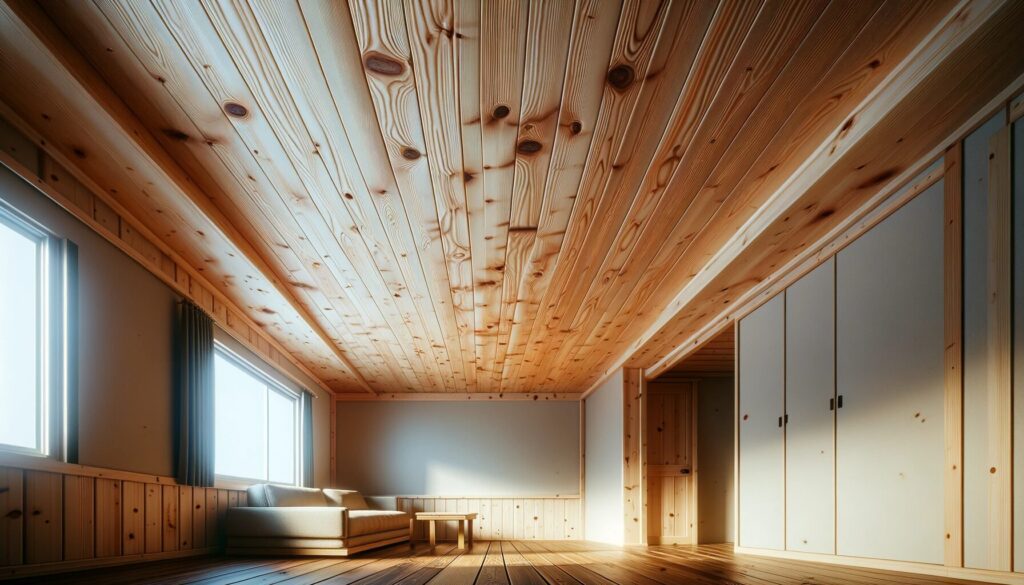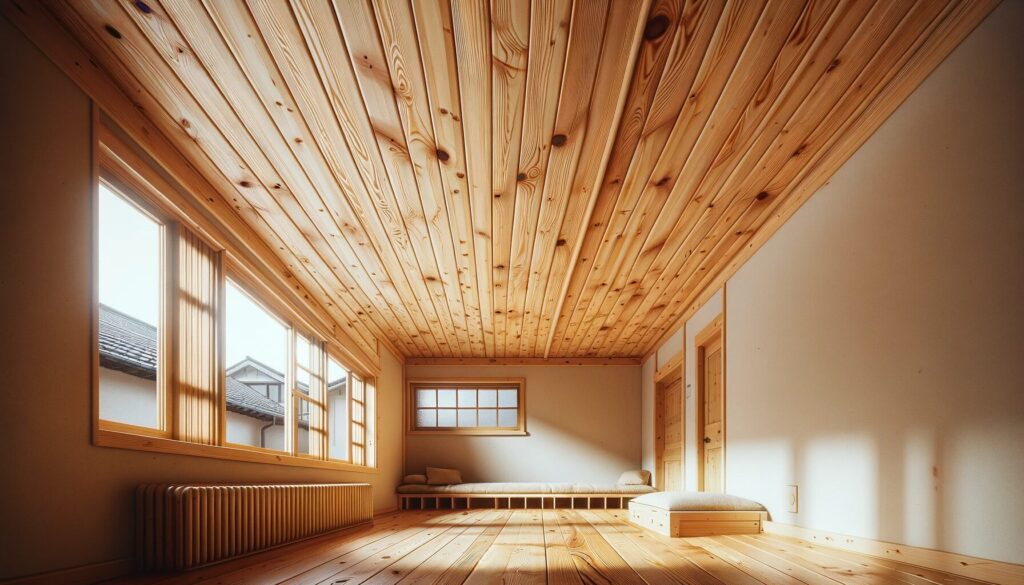In the ever-evolving world of home construction, wood ceilings are making a strong comeback. This isn’t just about a trend, it’s about rediscovering a classic element of home design that marries form and function. Wood ceilings, with their rich textures and varied styles, offer a unique blend of aesthetic appeal and practical benefits. They’re not only about creating an inviting ambiance but also about enhancing the value and comfort of your home.

Why Wood Ceilings?
The appeal of wood ceilings lies in their timeless beauty and durability. These ceilings add an extra layer of character to any room, creating an inviting atmosphere that can’t be replicated with other materials. Plus, they’re a smart choice for energy efficiency and sound insulation.
The Audience: From Newbies to Pros
Whether you’re a DIY enthusiast tackling your first project, a homeowner looking to upgrade your living space, or a professional builder, understanding the finer points of wood ceilings is key to a successful project. Let’s delve into the essentials of choosing, installing, and maintaining wood ceilings.
Understanding Wood Ceilings
What are Wood Ceilings?
Wood ceilings are more than just a decorative element, they’re a functional and versatile component of home design. Whether it’s the rustic charm of exposed beams or the sleek look of wood panels, these ceilings can transform any space.
A Touch of History and Modern Flair
The concept of wood ceilings dates back centuries but has evolved significantly. Today, they incorporate modern design elements and techniques, blending tradition with contemporary style.
The Versatility of Wood
Wood is not just a building material, it’s a design feature that offers a wide range of options in terms of style, texture, and functionality.
- Aesthetic Appeal: Wood ceilings add a layer of elegance and warmth.
- Acoustic Benefits: The natural properties of wood can enhance the acoustics of a room.
- Insulation: Wood acts as a natural insulator, contributing to energy efficiency.

Types of Wood and Their Characteristics
Choosing the Right Wood
The type of wood you choose for your ceiling can significantly impact the overall look and feel of the room. Here’s a rundown of some popular choices:
- Pine: A versatile and affordable option, ideal for achieving a cozy, rustic feel.
- Cedar: Known for its durability and resistance to moisture and insects, cedar is perfect for more challenging environments.
- Oak: A symbol of strength and longevity, oak adds a touch of luxury with its distinct grain and texture.
Understanding Wood Characteristics
- Grain Patterns: Each type of wood has a unique grain, influencing the ceiling’s visual appeal.
- Color Variations: Wood comes in a range of colors, each setting a different mood.
- Durability: Consider the wood’s resistance to environmental factors like humidity.
Tips for Selection
- Inspect the wood for quality and straightness to avoid future issues.
- Consider the room’s environment when selecting wood type.
- The right finish can enhance both the appearance and lifespan of your wood ceiling.
Wood Ceiling Styles and Designs
Delving into the realm of wood ceiling styles, we find a rich tapestry of options that cater to various tastes and architectural needs. Drawing from my extensive experience, I’ll guide you through the most sought-after designs that can transform your space, be it with a traditional touch, a contemporary flair, or a rustic vibe.
Exploring Diverse Styles
- Traditional Designs: Here, we’re talking about classic elegance. Traditional wood ceilings often feature intricate moldings and richly detailed paneling, reminiscent of historic homes but adaptable to modern settings. It’s about bringing a sense of time-honored craftsmanship to your space.
- Contemporary Styles: If your aim is a modern, sleek look, contemporary designs are the way to go. These are characterized by clean, uncluttered lines and often incorporate innovative materials and installation techniques for a minimalist yet striking effect.
- Rustic Ambiance: For those who prefer a more natural, earthy feel, rustic designs offer the perfect solution. Exposed beams, rough-hewn planks, and a natural finish create a cozy, cabin-like atmosphere that’s both welcoming and authentic.
Style Examples for Inspiration
- Wood Panel Ceilings: An excellent choice for adding depth and character. Whether opting for wide planks or narrower strips, wood panels can dramatically enhance the look of a room.
- Exposed Beam Ceilings: Exemplifying rustic charm, exposed beams are not just aesthetically pleasing but also impart a sense of architectural solidity.
- Coffered Wood Ceilings: For a more luxurious and intricate look, coffered ceilings with their sunken panels can add a sense of grandeur and sophistication to any room.
Tailoring to Each Room
- Living Rooms: Opt for a coffered or elegantly paneled ceiling to create a focal point that’s both stylish and timeless.
- Kitchens: Exposed beams work wonders here, adding warmth and character to both modern and traditional kitchen designs.
- Bedrooms: Softwood panels in tranquil hues can turn a bedroom into a serene retreat, conducive to relaxation and comfort.
Installation Techniques and Tips
Installing a wood ceiling can be a rewarding DIY project or an intricate professional undertaking, depending on the complexity of the design and the skills of the installer. Here, I’ll share some essential steps and tips to ensure a successful installation, based on my years of hands-on experience in the field.
Step-by-Step Guide for DIY Enthusiasts
- Preparation is Key: Start with a clean, smooth base. Remove any existing fixtures and ensure the ceiling surface is even and ready for installation.
- Measure Accurately: Accurate measurements are crucial. Always measure twice to avoid any missteps during the installation process.
- Locate the Joists: Use a reliable stud finder to locate the ceiling joists, as they will provide the primary support for your wood ceiling.
- Plan the Layout: Begin from a central point and plan your layout outward. This approach ensures a balanced and symmetrical installation.
- Secure Installation: Whether you are nailing, screwing, or gluing, make sure each piece is securely affixed to prevent future issues.
Professional Insights for Complex Installations
- Maintain Level and Square: Regularly check that your installation is level and square. Even slight deviations can be noticeable once the entire ceiling is installed.
- Allow for Wood Movement: Wood expands and contracts with changes in humidity. Always account for this movement by leaving appropriate expansion gaps.
- Consider Lighting and Fixtures: Plan for any lighting fixtures or ceiling elements in advance to integrate them seamlessly with your wood ceiling.
Essential Tools for the Job
- Measuring Tape: Precision is paramount, and a good measuring tape is indispensable.
- Stud Finder: A must-have for locating joists accurately.
- Saw: For cutting wood panels or beams to the correct size.
- Drill and Bits: Essential for pre-drilling holes and ensuring a clean, professional finish.
- Hammer or Nail Gun: Depending on the method of installation, a reliable hammer or nail gun is needed for affixing the wood to the ceiling.
- Level: A level is crucial for ensuring that each panel or beam is perfectly horizontal.
Finishing and Maintenance
A well-finished and maintained wood ceiling is not just a decorative element, but a long-term investment in your home. Through decades of hands-on experience, I’ve gathered insights on how to best preserve and enhance wood ceilings.
Finishing Options
- Staining: Staining highlights the natural beauty of the wood grain. Select a shade that complements your room, and remember to test it on a small, inconspicuous area first.
- Painting: Painting is an effective way to match your ceiling with the overall color scheme of the room. The key to a successful paint job is thorough preparation – sanding and priming are essential.
- Varnishing: Varnish not only enhances the appearance of your wood ceiling but also provides a protective layer, especially critical in areas with high moisture.
Maintenance and Cleaning
- Regular Dusting: Keep your wood ceiling dust-free with a soft brush or a vacuum cleaner with a brush attachment.
- Stain Removal: For stains and spills, use a mild cleaner and a soft cloth, avoiding abrasive chemicals to protect the wood finish.
- Pest Inspections: Regularly inspect for signs of termites or other wood-damaging insects. Early detection and treatment are crucial.
Addressing Common Issues
- Warping: Caused primarily by moisture fluctuations, maintaining consistent indoor humidity can help prevent warping.
- Moisture Resistance: In damp environments, a robust sealant can prevent moisture-related damage.
- Termite Protection: Regular professional inspections and preventive treatments are advisable, particularly in areas prone to termite infestations.
Innovative Ideas and Creative Inspirations
My journey in home renovation has exposed me to a wide range of innovative wood ceiling ideas, each bringing a unique character to the space. Here are some ways to make your wood ceiling a standout feature.
Worldwide Inspirations
- Drawing inspiration from global styles, from the minimalist approach of Scandinavian designs to the elaborate craftsmanship of Mediterranean ceilings, can infuse your space with an eclectic charm.
- Merging traditional materials with contemporary design elements, such as integrating reclaimed wood with modern lighting, can create a space that is both timeless and avant-garde.
- Strategic lighting, whether it’s sleek recessed lights or ornate chandeliers, can dramatically enhance the visual appeal of your wood ceiling.
Complementing with Lighting and Decor
- The right color palette and decor can harmonize the room, making your wood ceiling an integral part of the overall design theme.
FAQ Section
Wood ceilings offer unparalleled aesthetic beauty, enriching a room with warmth and elegance. They provide excellent insulation and are known for their durability and longevity when properly maintained.
The cost varies widely based on the wood type, design complexity, and whether it’s a DIY project or professionally installed. It ranges from a moderate investment to a more premium expense.
For simpler designs, DIY installation is achievable with the right tools and a bit of know-how. However, for intricate designs or if you’re unsure of your skills, enlisting professional help is recommended.
Regular dusting and occasional gentle cleaning are key. Keep an eye out for any signs of moisture damage or pest infestation and address these issues promptly.
Wood ceilings can be adapted to most climates, but the choice of wood and finish is crucial. Some woods are more suitable for humid environments, while others fare better in dry conditions. A suitable sealant can also make a significant difference in the longevity of the wood in various climates.
